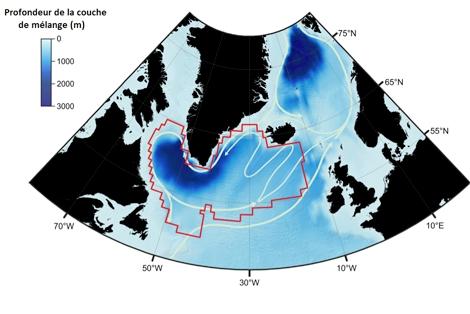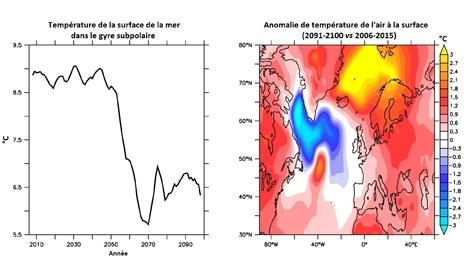[2017] North Atlantic: increased risk for abrupt cooling during the 21st century
The probability for an abrupt climate change around Atlantic has long been known and highlighted by the movie “The day after tomorrow”. In order to evaluate its risk, researcher from the laboratoire Environnements et paléoenvironnements océaniques et continentaux (CNRS/Université de Bordeaux) and University of Southampton have developed a new algorithm to analyze 40 climatic projections taken into account within the last IPCC report. This new study, published in Nature Communications the 15th of Fébruary 2017, gives a probability of 50% for an abrupt warming of North Atlantic during the 21st century.
The slowdown of the atlantic meridional oceanic circulation is detected in every projections from general circulation models and can have a strong climatic impact. In 2013, IPCC used results from 40 climatic projections and estimated that this slowdown will take place on a long timescale so that an abrupt cooling of North Atlantic within the 21st century was associated with a low probability.
Within the european EMBRACE project, a team of oceanographers examined again these 40 climatic projections focusing on the Labrador Sea where strong convection occurs as a driver for the atlantic meridional oceanic circulation. Here the surface water strongly cools down in winter leading to a density increase and hence a sinking of the water toward bottom of the oceanic column. In turn, heat from the deep ocean is transferred to the surface and prevent sea ice formation. The researchers developed an algorithm to study this convection effect in detailes through detection of abrupt temperature variations at the ocean surface. They thus revealed that 7 of the 40 models predict a complete shutdown of the convection, leading to abrupt cooling of 2-3 °C of the Labrador Sea and in the coastal regions of North Atlantic.
How realistic is such a cooling simulated by only 7 models ? In order to answer this question, the researchers investigated the driver of the winter convection, i.e. oceanic stratification. Vertical variations of water mass density are well reproduced I 11 of the 40 models. Within the 11 models, 5 simulate a decrease of the North Atlantic temperature.
These modelling results would be further compared to data obtained with the observing system of the international program OSNAP within the subpolar gyre hence helping to anticipate abrupt cooling in the coming years. This risk should also be taken into account in the adaptation policy for the North Atlantic regions.
Reference: Sgubin, G., Swingedouw, D., Drijfhout, S., Mary, Y., and Bennabi, A. (2017). Abrupt cooling over the North Atlantic in modern climate models. Nat. Commun. 8, 14375.
http://www2.cnrs.fr/presse/communique/4883.htm
Figure 1: Schematic representation of the circulation in the Labrador sea within the subpolar gyre circled by the red line.
Figure 2: Example for an abrupt cooling in the gyre as predicted by one climate model. Link: temporal evolution of sea surface temperature; right: difference in surface air temperature between the beginning and the end of the 21st century.


